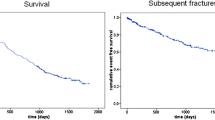Abstract
Hip fractures in older adults are a common event with a high risk of morbidity and mortality. Patients who sustain a hip fracture often present with multiple co-morbid conditions that can benefit from co-management by orthopedic surgeons and geriatricians. This manuscript describes a co-managed model of care for patients with hip fractures. This model of care will be explained, and the benefits and results will be described. Retrospective review of the care of all native non-pathological hip fracture patients aged 60 years and older admitted between April 2005 and March 2009 to a 261-bed community teaching hospital. The outcome measures include patient characteristics, length of stay, mortality, 30-day readmission, re-operation, and costs of care. Seven hundred fifty-eight patients were identified with an average age of 84.8 (SD 8.4); 77.8% of the patients were female, 94.7% Caucasian, and 37.3% from nursing homes, and the mean Charlson score is 2.9 (SD 2.1). The length of stay was 4.3 days, 30-day readmission rate was 10.4%, 17-month re-operation rate was 1.9%, and costs of care to the system were $15,188. The 1-year mortality rate was 21.2%. This model of care resulted in improvements in all measures studied. Previous studies have shown reduction in in-hospital complications. Additional studies are needed to show if this model of care can be translated to other systems or to other surgical conditions. Wide application of this model care could substantially improve the quality of care and cost of caring for frail elders with hip fractures.
Similar content being viewed by others
References
Melton LJ 3rd (1993) Hip fractures: a worldwide problem today and tomorrow. Bone 14(Suppl 1):S1–S8
Brauer CA et al (2009) Incidence and mortality of hip fractures in the United States. JAMA 302(14):1573–1579
Braithwaite RS, Col NF, Wong JB (2003) Estimating hip fracture morbidity, mortality and costs. J Am Geriatr Soc 51(3):364–370
Penrod JD et al (2007) Heterogeneity in hip fracture patients: age, functional status, and comorbidity. J Am Geriatr Soc 55(3):407–413
Jyrkka J et al (2009) Polypharmacy status as an indicator of mortality in an elderly population. Drugs Aging 26(12):1039–1048
Baranzini F et al (2009) Fall-related injuries in a nursing home setting: is polypharmacy a risk factor? BMC Health Serv Res 9:228
Friedman SM et al (2008) Geriatric co-management of proximal femur fractures: total quality management and protocol-driven care result in better outcomes for a frail patient population. J Am Geriatr Soc 56(7):1349–1356
Batsis JA et al (2007) Effects of a hospitalist care model on mortality of elderly patients with hip fractures. J Hosp Med 2(4):219–225
Phy MP et al (2005) Effects of a hospitalist model on elderly patients with hip fracture. Arch Intern Med 165(7):796–801
Beaupre LA et al (2006) Reduced morbidity for elderly patients with a hip fracture after implementation of a perioperative evidence-based clinical pathway. Qual Saf Health Care 15(5):375–379
Miura LN, DiPiero AR, Homer LD (2009) Effects of a geriatrician-led hip fracture program: improvements in clinical and economic outcomes. J Am Geriatr Soc 57(1):159–167
Friedman SM et al (2009) Impact of a comanaged Geriatric Fracture Center on short-term hip fracture outcomes. Arch Intern Med 169(18):1712–1717
Graban M (2008) Lean hospitals: improving quality, patient safety, and employee satisfaction, 1st edn. Productivity, New York, p 276
Robertson BD, Robertson TJ (2006) Postoperative delirium after hip fracture. J Bone Joint Surg Am 88(9):2060–2068
Robinson TN et al (2009) Redefining geriatric preoperative assessment using frailty, disability and co-morbidity. Ann Surg 250(3):449–455
Berry SD et al (2009) Survival of aged nursing home residents with hip fracture. J Gerontol A Biol Sci Med Sci 64(7):771–777
Tinetti ME et al (1999) Home-based multicomponent rehabilitation program for older persons after hip fracture: a randomized trial. Arch Phys Med Rehabil 80(8):916–922
Sieber FE et al (2010) Sedation depth during spinal anesthesia and the development of postoperative delirium in elderly patients undergoing hip fracture repair. Mayo Clin Proc 85(1):18–26
Handoll HH, Sherrington C (2007) Mobilisation strategies after hip fracture surgery in adults. Cochrane Database Syst Rev (1): CD001704
Karunakar M et al (2009) Improving outcomes after pertrochanteric hip fractures. Instr Course Lect 58:91–104
Sieber FE (2009) Postoperative delirium in the elderly surgical patient. Anesthesiol Clin 27(3):451–464, table of contents
Inouye SK (2001) Delirium after hip fracture: to be or not to be? J Am Geriatr Soc 49(5):678–679
Marcantonio ER et al (2001) Reducing delirium after hip fracture: a randomized trial. J Am Geriatr Soc 49(5):516–522
Kates SL, Blake D, Bingham K, Kates O, Mendelson DM, Friedman SM (2010) Comparison of an organized geriatric fracture program to United States government data. Geriatric Orthopaedic Surgery and Rehabilitation 1(1)
Conflicts of interest
The authors received a research grant from Synthes, USA. Research grant from AO Research Foundation and direct funding from the Highland Hospital of Rochester
Author information
Authors and Affiliations
Corresponding author
Rights and permissions
About this article
Cite this article
Kates, S.L., Mendelson, D.A. & Friedman, S.M. Co-managed care for fragility hip fractures (Rochester model). Osteoporos Int 21 (Suppl 4), 621–625 (2010). https://doi.org/10.1007/s00198-010-1417-9
Received:
Accepted:
Published:
Issue Date:
DOI: https://doi.org/10.1007/s00198-010-1417-9




